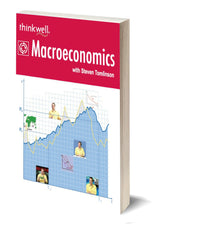
Macroeconomics compatible with AP®* Online Course
$169.00
Thinkwell's Macroeconomics compatible with AP®*
Thinkwell's Macroeconomics compatible with AP® follows the AP® topics outline and is typically taught in one semester. Taught by acclaimed Professor Steven Tomlinson, one of America's most talented professors, it's a great way to learn the economics of markets and countries, and how they interact.
Thinkwell's Macroeconomics compatible with AP® is the same course as Thinkwell's Honors Macroeconomics: we've branded this way to bring it to the attention of those looking to take the AP® exam, as many students have had great success using this course in preparation.
The Printed Notes (optional) are the Thinkwell Honors Macroeconomics course notes from the Online Subscription printed in color, on-the-go format.
*(AP® is a registered trademark of the College Board, which was not involved in the production of this product. This course is designed for self-study preparation for the AP® exam and has not been audited by the College Board.)





